Vietnam's Mekong Delta at a glance for sustainable agricultural transformation
Climate change is set to have a major impact on agricultural water management in Vietnam’s Mekong Delta – the country’s main rice-producing region, and a leading player on the world market.
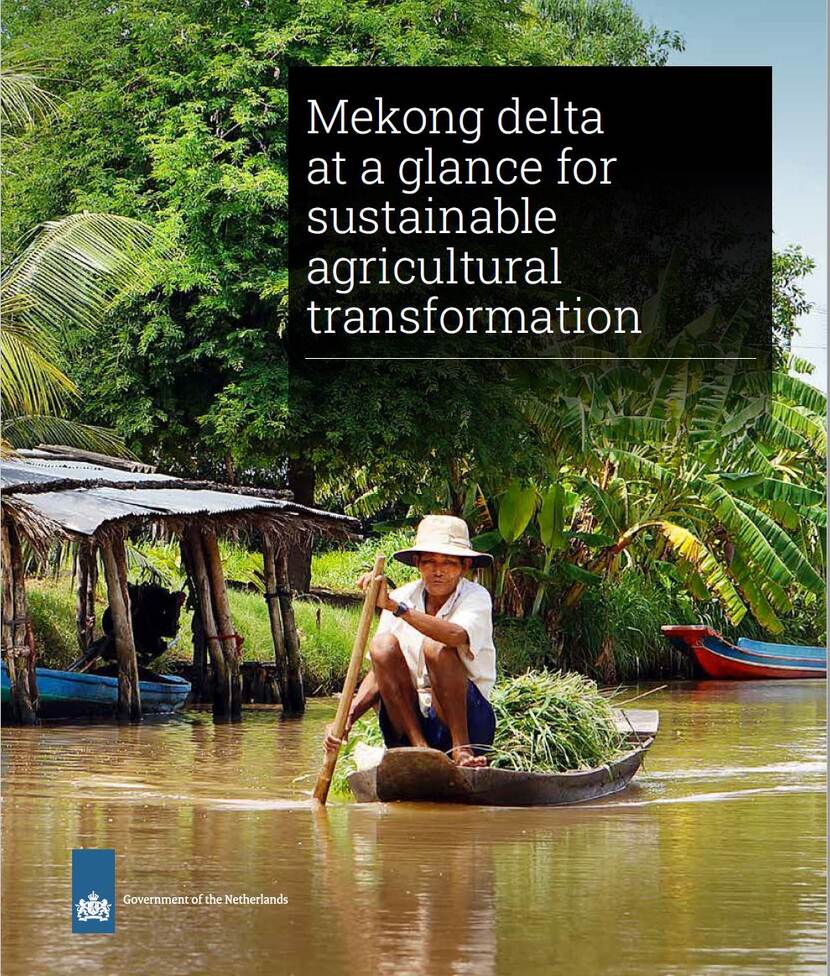
The scarcity of fresh water, along with far-reaching saltwater intrusion and increasingly severe river flooding, is already having an impact on agricultural production, and will continue to do so. While this poses a threat to today’s agricultural system, it’s also an opportunity to transition to more sustainable and high-value forms of agriculture that are better suited to new approaches to water management. These opportunities have been identified and outlined in the Mekong Delta Plan and subsequently in the government’s Mekong Delta Integrated Regional Plan. In essence, the aim is to transform agriculture to make it better suited to changing circumstances, rather than trying to manage the impacts of climate change itself. A visual summary of this approach you can find here Mekong Delta at a glance for sustainable agricultural transformation | Publicatie | Agroberichten Buitenland
Reconceptualising the use of salt water and fresh water
The impacts of climate change and upstream developments are triggering a reorganisation of the Mekong Delta into three agro-hydrological zones:
- Saltwater/brackish coastal area
- Saltwater-freshwater middle delta where water management is based on the availability of fresh water during the rainy season and saltwater intrusion during the dry season (up to 60km inland)
- Permanent freshwater zone of the upper delta
This calls for a reorientation of agricultural development in the delta, shifting substantially away from the rice-dominated trajectory of the past few decades. Low-value rice production along the delta as a whole can no longer rely on the availability of fresh water, and economic growth in the delta will have to be based on higher-value agricultural production. The latter can be achieved by encouraging aquaculture (shrimp, fish and seafood) and fruit and vegetable cultivation, for which the added economic value is greater by a factor of respectively 10-50 (aquaculture) and 10-20 (fruits and vegetables) in comparison to rice.
This is also captured in government resolution #120 which sets the priorities for agricultural development as: aquaculture – fruits/vegetables – rice. This is a complete reversal of previously implemented policies and developments. The three agro-hydrological zones have now been formally adopted in the government plans, which call for a saltwater-based (aquaculture-dominated) coast, an intermittent fresh-saline middle delta and a permanently freshwater-based (rice-oriented) upper delta. These plans project that rice production will decline by 35 percent (from 24 metric tonnes in 2018 to 16 metric tonnes in 2050), making room instead for a doubling of fruit and vegetable production, and the sustainable growth of the aquaculture sector.
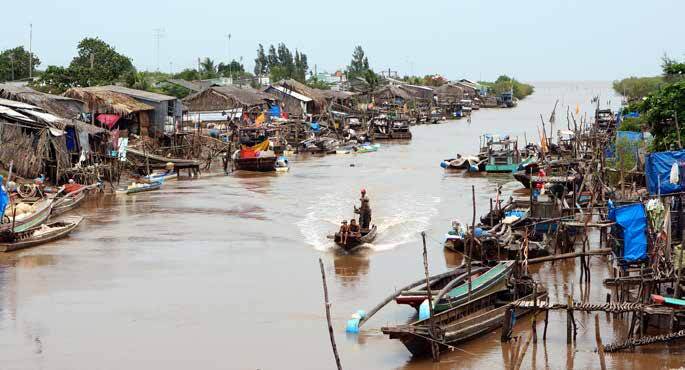
Adaptive sustainability – from monoculture to polyculture
For agriculture to adapt to new forms of water management in each of the three zones, it must not only adjust the nature of water use (in terms of time and volume) but also make the whole production system more sustainable both in terms of soil and water quality and the provision of climate-adaptive landscape functions. This means the production systems have to be organised to meet multifunctional requirements.
Saltwater coast
In the saltwater coastal zone this calls not only for aquaculture to be aligned with access to saltwater, but also for the facilitation and assurance of a number of sustainability and adaptation functions:
- Total avoidance of groundwater use (frequently relied on in shrimp farms to manage salt levels) in order to limit acute land subsidence;
- A symbiotic and conducive relationship with the growth of mangrove forests along the coast in order to improve natural coastal defences against rising sea levels (with the aim of restoring at least a 500-metre strip of mangrove);
- Bringing about a nutrient cycle in which nutrients from feed are recycled to improve water quality and wastewater is re-used;
- Separation of water inflow and outflow to ensure access to high-quality, clean salt water, and the safe disposal of wastewater.
These requirements can be met through the redesign of the coastal aquaculture landscape, using what’s known as a cascade polyculture system (see figure) providing:
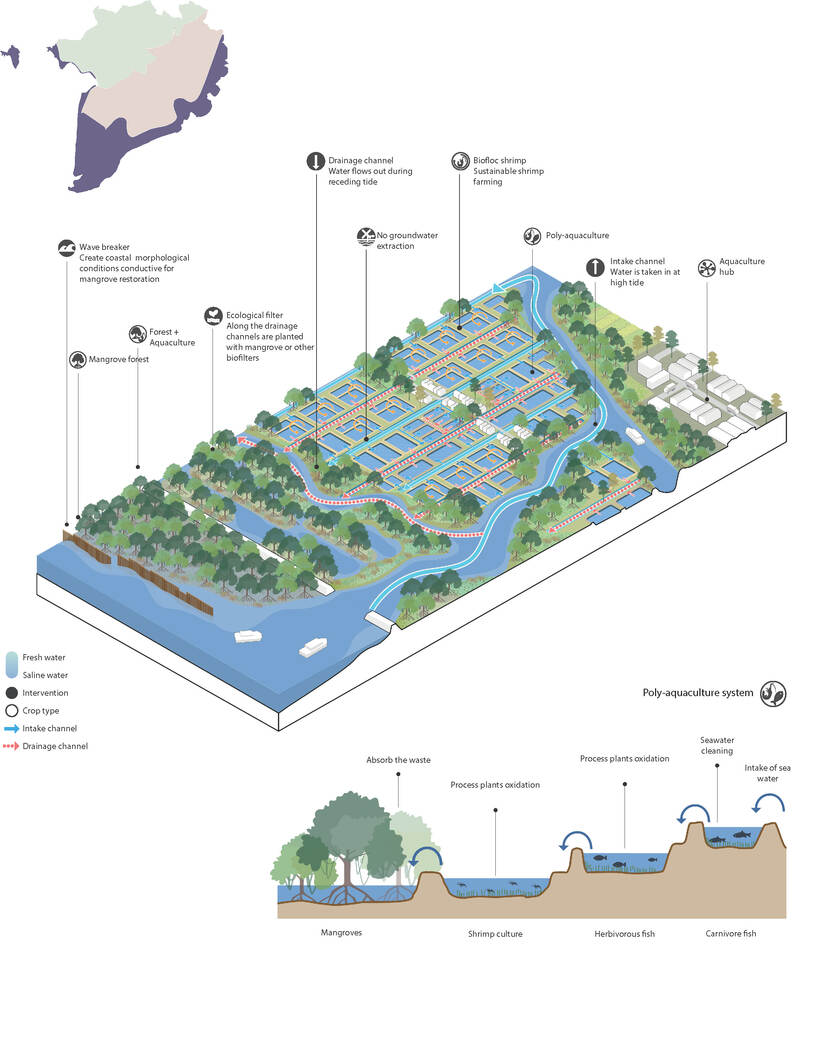
- Separate water inflow and outflow
channel system (inflow during incoming
tide, and outflow during outgoing tide)
- Cascade of aquaculture ponds, in which water flows in and along carnivorous fish, herbivorous fish and shrimp farms as it moves towards the outflow (water & nutrient circulation & quality)
- Outflow passing through the mangrove forest before being discharged at sea to ensure nutrient circulation both inland and offshore.
Innovation agenda:
The innovation agenda for the saltwater/brackish aquaculture sector therefore includes:
- The development and coordination of various polyculture systems using fish (herbivores, carnivores), seaweed and seagrass (nutrient cycle) and shrimp in varying degrees of intensity
- Optimisation of water circulation and recirculation systems in aquaculture (RAS), both at system and farm level, and in hybrid forms.
- The development of non-intrusive cultivation methods/systems for mangrove aquaculture (i.e. shellfish and crabs) that do not affect the integrity of the mangroves (safeguarding their coastal defence function).
- The development of applications and markets for by-products: seaweed and seagrass for feed, food products and the cosmetics industry.
Intermittent fresh-saline Middle Delta
Rice-Shrimp
In the intermittent fresh-saline middle delta, the seasonal water management shift from fresh water to salt water presents the greatest challenges to creating an agricultural system that is at once adaptive and productive. The traditional rice-shrimp cultivation system is most naturally suited to these conditions. Government plans therefore anticipate strong growth for this cultivation system (in terms of both volume and area), particularly as a result of turning the system of two rice crops into a rice-shrimp cultivation system. Improving the sustainability and productivity of this system will require the following innovations:
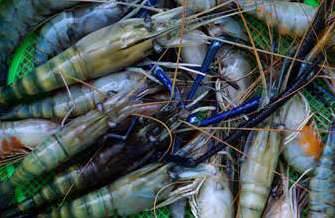
|
- The development of innovative cultivation systems to improve the added economic value of the integrated rice-shrimp cultivation system:
- Combining rice with freshwater prawn cultivation (in situ);
- Transitioning from extensive to partially intensive saltwater shrimp cultivation, with nutrient circulation at the farm level.
Salt-tolerant cultivation
The intensity and duration of salt intrusion is increasing in the downstream middle delta, with the 2016-19 extremes set to become the new normal. This is driving the imperative to switch to salt-tolerant crops, which are currently still scarce in terms of their variety and market presence. Coconut is currently the standard alternative for perennial fruit cultivation and the sector has seen massive growth over the past few years. This growth is expected to continue. Pineapple is another growth sector within fruit cultivation, and its high level of salt tolerance makes it suitable to this zone. Salt-tolerant fruit and vegetable cultivation will, however, remain an important part of the innovation agenda, requiring further development in terms of varieties and markets.
Freshwater fruit and vegetable cultivation and water storage
Freshwater fruit and vegetable cultivation will mainly be confined to the upstream middle delta, where there’s the greatest scope for prolonging the season for freshwater management. For fruit this would initially require saltwater intrusion measures (sluices) as long as there is an assured supply of fresh water from the upper delta. For vegetables, the length of the season would need to be adapted. Short-season vegetables (30-60 days) are ideal for this region, as they offer the flexibility to match cultivation intensity (3, 4 or 5 crops) to the availability of fresh water.
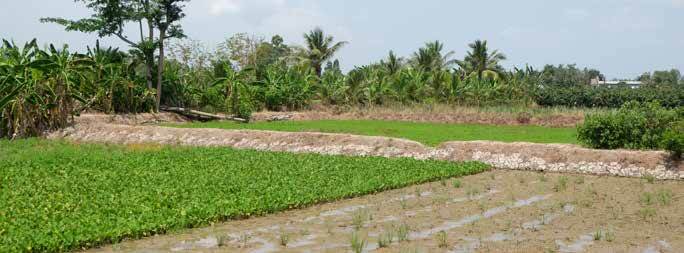
The only sustainable way of prolonging the freshwater season is to store excess fresh water during the rainy season (the use of fresh groundwater as a supplementary source for agriculture is to be avoided due to land subsidence). This calls for the design and development of new integrated cultivation systems, combining surface water storage with the cultivation of fruits and short-season vegetables.

The challenge lies in making these cultivation systems economically viable: this would require high-value fruits and vegetables, and the combining of water storage with freshwater aquaculture and/or floating vegetables in the water reservoir.
These approaches would be necessary to compensate for the cost of investment and the loss of agricultural land.
Agricultural systems in the middle delta will thus move towards a mixed and integrated system like rice-shrimp, salt-tolerant vegetables & fruits, freshwater fruits and vegetables with water storage (see figure) which: (i) follows the freshwater-saltwater gradient from upstream to downstream; (ii) is adapted to the varying durations of the fresh- and saltwater seasons; and (iii) becomes progressively more saltwater-based as the impacts of climate change increase. Water infrastructure and management will need to be integrated and coordinated as part of this, to ensure the separate management of fresh water and salt water.
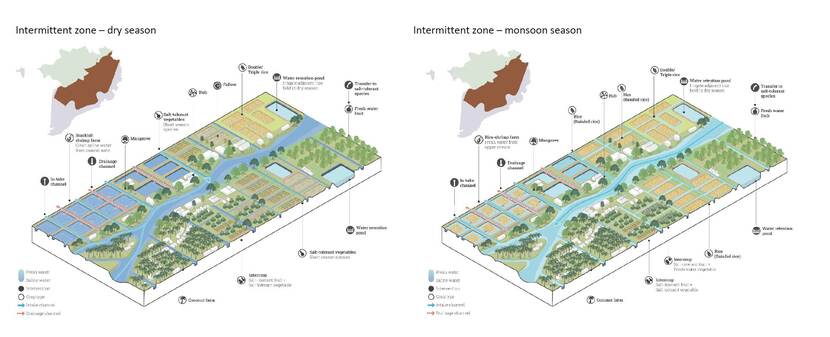
Freshwater upper delta
In the upper delta, where there is guaranteed access to fresh water all year round, rice will continue to be the main crop. As a low-value crop, it will require economies of scale and automation. However, adaptive measures will be needed in order to accommodate extreme river discharges (caused by more intense rainfall).
This could be achieved by restoring the two-season rice cultivation system followed by flooding, and/or introducing a disaster policy in which three-season rice paddies are designated as floodplains in an emergency. This will become a focus area for freshwater aquaculture (pangasius, prawns, snakehead fish), as it’s the only zone where the supply of fresh water can be guaranteed in the future.
Conclusion
The integrated regional plan (MDIRP) for 2030-50 recently adopted by the government sets out an adaptation and transformation strategy for agriculture. Agriculture will have to adapt to new forms of water management. The creation of freshwater, intermittent fresh-saline and saltwater zones will support the spatial planning of agriculture based on the suitability of local conditions. The innovation and transformation agenda will be determined by: the sustainability principles of each zone and cultivation system; the adaptation functions that need to be met (no groundwater extraction, coastal defences, space for salt water and flooding, etc.); and objectives for higher-value agriculture. Setting in motion a transition from low-value rice farming to aquaculture, vegetables and fruits opens up opportunities for high-value production systems based on both fresh water and salt water. By initiating the formation of 8 agribusiness hubs, spread across the delta according to the various production systems used in the agricultural hinterland, the government aims to stimulate and steer the creation of this added economic value.
Do you have any questions for the agriculture department please send an email to HAN-LNV@minbuza.nl For the latest updates, news funding opportunities and more follow us on Twitter @AgroVietnam.